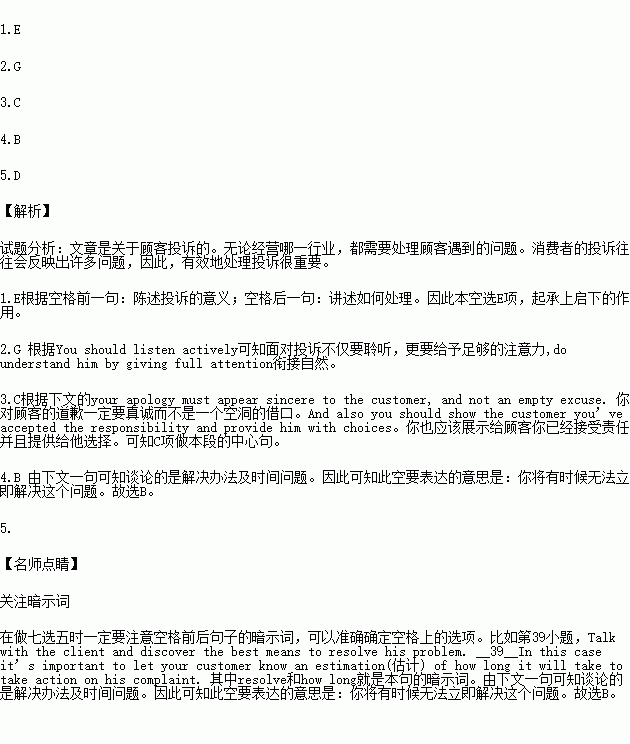题目内容
No matter what type of business you run, it has to deal with things that go wrong from your customer’s point of view. Complaints can be a great source of information for organizations to make corrections as well as further improvements. __1.__.
You should listen actively to what the customer has to say by maintaining comfortable eye contact. _2.__.
__3._.It’s important for you to know that your apology must appear sincere to the customer, and not an empty excuse. And also you should show the customer you’ve accepted the responsibility and provide him with choices or assure the customer you’ll do something about his complaint.
Talk with the client and discover the best means to resolve his problem. __4.__In this case it’s important to let your customer know an estimation(估计) of how long it will take to take action on his complaint.
A simple “thank you” is one way to let the customer know you appreciate the time and effort they’ve taken to inform you about a problem with your company’s service or product that you need to know about.
Create a procedure for recording different types of customer complaints. __5.__.
A. Listen to your customer’s complaints and you can improve your service.
B. There will be times when you’ll be unable to resolve the issue immediately.
C. When receiving a complaint, you should apologize for the failure the customer has identified.
D. They are a valuable source of information to determine various root causes that need to be addressed within your company.
E. So it’s important to learn to deal with customer complaints efficiently.
F. Don’t feel ashamed of the failure in your service or products.
G. You should also show your customer that you do understand him by giving full attention.
Su Hua is studying at Cambridge, UK. She has bought a bicycle and is worried about security (安全). Her friend, Kate, found this article and sent it to her.
Introduction A lot of crime is against bicycles. About 150,000 bicycles are stolen every year and most are never found. You can prevent this happening by following a few careful steps. Basic Security Do not leave your bicycle in out-of-the-way places. Always lock your bicycle when you leave. Secure it to lampposts or trees. Take off smaller parts and take them with you, for example lights and saddles (车座). Locks Get a good lock. There are many different types in the shops. Buy one that has been tested against attack. Ask for a recommendation from a bike shop. Marking Security marking your bike can act a deterrent to a thief. It can also help the police find your bicycle. It should be clearly written and include your postcode and your house or flat number. This will provide a simple way to identify your bicycle. Registration There are a number of companies who will security mark your bicycle for you. They will then put your registration number and personal details on their computer database. Then if your bicycle is found it will be easy to contact you. Finally Keep a record of the bicycle yourself: its make, model and registration number. You can even take a photograph of it. This will prove the bicycle belongs to you. |
1.Which part of the text gives you information on how to lock up your bicycle when you leave it?
A. Locks. B. Marking.
C. Registration. D. Basic Security.
2.The underlined phrase “act as a deterrent to a thief” means ______.
A. help you recognize your bike
B. help the police find your bicycle
C. stop someone stealing your bicycle
D. stop you worrying about your bike
3.The main purpose of this article is _________.
A. to tell you what to do if your bicycle is stolen
B. to suggest ways of keeping your bicycle safe
C. to give you advice on where to buy a good lock
D. to say why you shouldn’t keep your bicycle in a quiet place
书面表达
假设你应邀参加学校组织的“英语学习师生座谈会”,请你根据下表所提示的信息,用英语写一篇发言稿,简单介绍自己英语学习的情况,并对学校今后的英语教学提出建议。
自己英语学习的情况 | 1、英语学习的目标; |
2、英语学习的方法; | |
3、课外自学的途径; | |
…… | |
对学校英语教学的建议 | (请考生根据自己的经历与感想,提出两至三点建议。 |
注意:1、对所给要点逐一陈述,适当发挥,不要简单翻译。
2、词数100左右。开头和结尾已经写好,不计入总词数。
3、文中不得提及学生所在学校和本人姓名。
Dear teachers and schoolmates, it’s a great pleasure for me to be here today and share my experience of learning English with you.
Thank you for listening.

